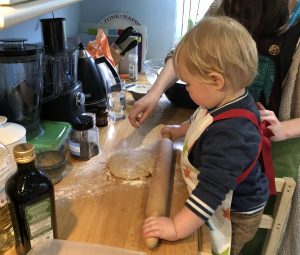
What’s that smell? Episode 7
Right – quick recap: Piglet appears to be allergic to cow’s milk and soya. I’m allergic to cow’s milk. My wife (Piglet’s mummy) is breastfeeding him and therefore cannot herself consume any of Piglet’s allergens either.
This presents a few, shall we say, challenges. We have to create a balanced diet for the three of us at home. Considering that my wife’s favourite meal is lasagne with Asian greens (basically a hot pot of cheesy cow’s milk and soya!) that meant some serious changes. On top of that, we have to make sure that the other people who feed Piglet are educated in what to feed him/avoid. Thirdly, we need to make sure that whenever we need anyone else to cook for us (eating out/purchasing food on the move) that we know how to do all this safely. Piece of cake, right? Mmm, cake. Well, exactly…

Cake, daddy? Ok – let me just set the oven…
Luckily on the first point we had a head start. Having avoided milk on and off from childhood I at least had a good idea of how to create and what to avoid in a cow’s milk-free diet. There are the obvious things: don’t eat butter, no cheese, use milk alternatives, no milk chocolate etc… Then there are the less obvious adjustments: biscuits will often contain milk powder or whey, most pastry products contain butter, a lot of sauces will contain yoghurt or butter etc… You quickly learn which things will need checking and which don’t (I’ve become pretty quick at scanning ingredient lists for allergens).
Soya on the other hand was a new one for both of us. And it turns out that it’s in things I would never had thought to check… The most significant thing, it turns out, is that soya flour is used in virtually anything that wheat flour might be used in: bread, batter, cakes etc… Just getting our hands on bread that was soya-free in the first few weeks was really difficult. In the end we got a bread-maker and make several loaves a week for ourselves but we do at least now know that there are specific brands/types that are suitable once you know where to look: Jackson’s, available from Waitrose is one, if you’re interested. Another soya trip hazard is gravy, nearly all instant gravies contain it. The only one I’ve found that doesn’t is old-school Bisto original gravy powder (the kind you have to make up from a paste with cold-water and then heat up – turning into horrible gravy slugs if you forget to stir it).
Chocolate is a beautiful combination of the two allergens. Obviously any milk chocolates have to be avoided from the start. But a huge surprise was that most dark chocolates, if lucky enough to not contain milk, almost certainly contain soya lecithin as an emulsifier. There are a handful of suitable alternatives: Booja-booja do a range of truffles which are exceptional. Green & Blacks also do a Velvet Edition range that has some dairy and soya-free options. You’d think that having such a limited range of chocolate would significantly reduce how much eat – but I think we probably eat as much chocolate now as ever – it compensates for the other desserts we can’t eat!
We eat roughly the same kind of stuff that we used to before we found out about the allergies. I guess with soya sauce bring such a key feature of Chinese cuisine, we probably eat less of this than we used to. There are fairly good soya sauce substitutes (Maggi liquid seasoning or coconut aminos) but everything needs making from scratch as it’s hard to buy soya-free kits/sauces. I used to love duck pancakes, for example, but I’ve never found an equivalent hoisin sauce replacement. That said, I do love a coconut milk curry so we I guess we eat more Thai/Indonesian food as a result to compensate for some of the Chinese dishes we start to miss.
I don’t know if its a result of having been a vegetarian as a child, my wife’s Asian inspired cuisine or just our preferences as adults (despite having both lived in Yorkshire for 4 years) but we’ve never really been a ‘meat and two veg’ kind of family. So we tend to cook meals of various, but specific, national influence. There’s a quite a lot of pasta: various tomato sauces: bacon, bolognese, lasagne etc… Or we’ll have fairly simple anchovy or prawn pasta dishes with just olive oil or a touch of oat cream. We also like spicy food but eat less of it as Piglet eats more and more the same meals as us. I can’t really hold it against him but his chilli tolerance isn’t quite developed yet. So we’ll make things like chilli con carne or any Mexican dish that be made without cheese or sour cream. We go through a LOT of avocado in this house since we learnt how to make guacamole. We try and include at least one vegetarian/vegan meal a week – both from a shopping cost perspective and to force us to have some variety from our default meat meals that we slip back to.
Piglets favourite meal seems to be a Sunday roast. I’m not sure why, it’s not an obvious baby/toddler food but in particular he seems to just adore roast chicken! He also really likes his vegetables (broccoli, sweetcorn, peas, you name it…). And we probably eat more veg now he’s around, both because he likes it and because we’re more structured in getting a balance of nutrients than we used to be when it was just the two of us. For the vast majority of meals I’ve listed you can make them dairy and soya-free with no or minimal adjustments. In fact, the more we make from scratch the easier it is to do – the problems usually start to appear when we’re trying to use a packaged sauce or a bought spice mix etc… The cost (aside from the actual cost – we do seem to spend an exorbitant amount on our weekly shop) of cooking like this is the time it takes. We spend a lot of time cooking compared to other families. Part of this is by choice. I really enjoy cooking and find it a welcome distraction from other parenting tasks. But there are certainly nights when, still cooking at 11pm, I wish I’d found quicker ways to do it all.

Yikes – it is one of the little trolleys – honestly!
So that covers what we do in cooking for Piglet and ourselves. But obviously, it’s not always us doing the cooking. If we’re pushed on it, I think both my wife and I are slight control freaks – and so allowing others to cook for our dietary requirements is both a technical and emotional challenge at times. In general, both sides of the family have been really good at adjusting to cooking for us. Although with various levels of stress at different stages of the educational curve.
I think one of the first challenges was just being firm and clear enough with ourselves and our families that it was going to be something that was tackled head on. Lets be honest, food allergies were just not as prevalent in the previous generation as they are now. I don’t know why that is, I wouldn’t dare speculate, but just because they’re new (in generation terms) doesn’t mean they’re not real. Such is the nature of non-acute food allergies and the complexities in diagnosing them that I think we’ve had to do some persuading that we’re as sure as we are that the allergies exist. Not that we’ve ever been told that we’re wrong; it’s just hard to fully appreciate the scale of the problem when Piglet is back home before the reaction even kicks in.
I think one of the eye-opening moments was leaving Piglet with the grandparents for a one-night getaway back in the summer of 2017. He’d been given a baked potato with butter for his lunch (despite a clear discussion about allergies when ordering) and he’d probably eaten more of it than we’d realised before we noticed. As an aside, this is probably the most common trip-hazard for us in ordering food. Any discussion about allergens discuss the ingredients in the named thing and those will often come from the chef themselves. However, if in the serving process extra items are added this is where it can go wrong. Butter on toast, butter in jacket potatoes, dressings on salads etc… Anyway, back to the point I was making: we left Piglet with the grandparents just as the reaction was kicking in (unbeknown to us). When we met up with them again the next day they listed all of the various things he’d struggled with (flatulence, colic, poor sleep, very clingy, multiple [unpleasant] nappy changes etc…). I think hearing us explain that every single one of these could be traced back to the jacket potato he partially ate for lunch was a paradigm shift for everyone. It was certainly easier to have the conversations about what to avoid after that even if not necessarily easier to explain what that meant to include.
It’s really difficult to advise how to cook for us. Obviously it’s possible to see the allergens on any ingredients you’re buying from a supermarket – but that’s not the same as helping to suggest what meals are going to be easy for them to cook for you. You end up with a hybrid between helping them find substitutes for the meals they were otherwise likely to plan to make and suggesting ‘easy’ meals from scratch that they can make that they might not have made before. The other part that’s difficult is working out how much autonomy to encourage. It’s great when someone just offers to cook for you and take ownership of the allergen management. But there’s always the fear that the confidence doesn’t match the challenge. Actually in general that hasn’t been the case but it’s always difficult to get the balance between trusting that someone has it under control and double and triple checking some of the ingredients. Its just a case of having the conversations: making it clear why it matters so much, asking the questions necessary to eat with confidence while not making the experience so awkward for the host that you don’t want to eat there again. I guess part of this is the motivation for doing this blog in the first place: I hope it resonates with people dealing directly with these allergy and parenting quirks – but it’s also a relevant piece for anyone who knows someone with allergies; a kick start to the conversation, shall we say.

Notice the extra care that goes into setting the table when it’s just a meal for two!
The final part of the puzzle is eating out. Whether you want to do it for the joy of being cooked for, or just find yourself in need of food while out of the house; eating out is inevitable irrespective of your allergies and how severe they are. It’s been in the news and on social media quite a lot lately around the Pret allergy deaths that perhaps the people shouldn’t have been eating there in the first place. What I think some people struggle to understand here is that eating is a basic human need and in order to do it safely you need to buy your food from somewhere. We simply don’t live in a world where it’s practical or sensible to expect people to be self sufficient. And therefore the “if I had an allergy, I wouldn’t take the risk” argument misses that someone has to be responsible for making sure that food can be purchased with accurate labelling. To draw an arbitrary line that says supermarkets need to be accountable but fast-food outlets not makes no sense to me.
That said, some places are easier than others and it can be about picking your battles. I am under no illusion that the £325, 12-course tasting menu that they serve at the Fat Duck just down the road from me is going to be able to be made suitable for my family’s requirements (although looking on their website – they do claim to try – kudos to them!). But I do expect to be able to find somewhere to eat an evening meal when we’re driving back from Liverpool to Windsor on a Sunday night… To be fair, despite my tone of doom and gloom, there are some places that do 100% get it. Brilliant places that completely understand how important the allergies are, make it really easy to ask questions (including double checking things that you’ve already requested to be particular allergen free) and provide extensive food labelling and allergen menu options to help make your decisions.
I can’t list all of the establishments that deserve credit but there are some that do stand out: Wagamama’s, Pizza Express, Zizzi, Ask Italian and GBK are some of the chains that deserve a special mention. Unfortunately, such is the importance of branding in the trust issues of dealing with allergens, the food chains that get it right get to see the benefit of our custom at their stores all over the UK. With independent restaurants, it can be really hit and miss. Some go above and beyond, others seem to see it as a tick-box exercise. My knowledge of independent restuarants across the UK is far from extensive (I didn’t eat in a restaurant until I was 16-17 for a start) but Stratton’s Hotel in Swaffam and The Pig and Pastry in York were brilliant. It’s as much about the customer service around it as it is the resulting items on the menu you can eat.
The issues with all eating out is the trust. At some point, you are effectively handing over the responsibility for eating safely to someone you’ve (probably) never met before. I’ve basically not eaten in some places where I feel I’m being given the ‘yes’ treatment. “If I have this without the cheese, would it be dairy free?” “Yes, yes, we can do anything you need”… While it’s the appropriate response, it’s very hard to follow that comment with “Great – but what I really need is for you to tell me whether it’s suitable”. In contrast I’ve walked into some places (generally because we’ve exhausted all other options) and not really expected to get any assurances only to be blown away by how seriously they take it: “So you can definitely have this, you can’t have that and I’d have to check this with the chef. But I’ll double check everything with the chef when I put the order in and come back to you if there are any problems.”
Good service can take away all your worries and instantly relax you; poor and non-reassuring service can suddenly add anxiety. Add the pressure of having family and/or friends waiting on your ‘sign-of’ that you’ll be able to eat in this place and I’m not completely beyond turning into a blubbering wreck. But I’ve never been the calmest of restaurant eaters in the first place. Starting with a ten (?) year handicap probably doesn’t help. I really hope that Piglet grows up to be a much more confident diner than I was; but at very least I hope that by the time he’s 20-years-old he can at least know that he can go somewhere and order food that won’t make him ill with confidence. But hopefully by the time he’s 20, he might not still be allergic to both milk and soya. We’ve already been looking into the process of re-introducing the allergens. But that’s something for next week’s post!
Toodlepips
x